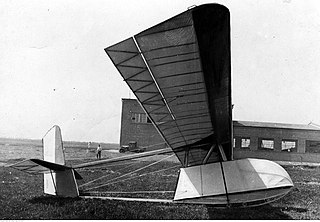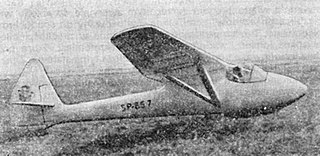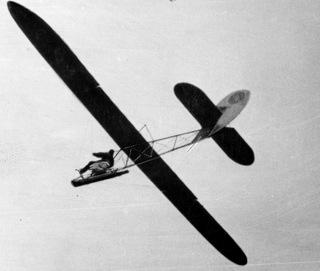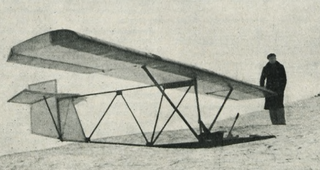The Czerwiński Sparrow, sometimes known as the de Havilland Canada glider, was a single seat glider, designed and built by a group of de Haviiland engineers in Canada in 1942. It was intended to popularise gliding and be suitable for both basic training and thermal soaring.
The Teichfuss Allievo Pavullo was an Italian single seat open frame primary glider, designed by Luigi Teichfuss of Pavullo and first flown in 1940. It was sold in two versions, strut and cable braced. A single two seat variant was also built.

The Gabriel P 5 was the first nationally developed aircraft to fly in Poland after it became independent in 1918. It was an amateur-built, low-powered, single seat parasol wing machine. Only one was completed.
The Czerwiński CW II,, was a Polish open frame glider. In 1929 it set a new national duration record and flew successfully until the end of 1931, when several major structural and aerodynamic modifications improved its performance. A simpler, lighter version, the CW III,, was designed and built in parallel with it and became Poland's first production glider.

The Czerwiński and Jaworski CWJ was a basic training glider designed and flown in Poland in 1931. Between eighty and one hundred examples of it and an improved variant, the CWJ-bis Skaut, were built.

The Blaicher B.1 was a Polish glider first flown in 1934. It was intended to fill an intermediate trainer role, but offered no advance on existing aircraft and only the prototype was completed.

The Czerwiński CW 7 was a Polish aerobatic glider first flown in 1934. Despite a structural weakness that prevented inverted flight, a small batch of CW 7s were used by several aeroclubs until the start of World War II.

The Czerwiński CW 8 was a mid-1930s Polish open-frame basic training glider. Its design was advanced and its price low, but its stalling characteristics were too dangerous for beginners, so the thirty-plus examples completed were rapidly withdrawn from use. Two were subsequently modified, one with greater span and the other with a small engine.

The Czajka (transl. Lapwing) or Kocjan Czajka after its designer was a Polish secondary training glider which was in continuous production from 1931 to the start of World War II. More than 160 were completed in Warsztaty Szybowcowe in Warsaw.

The D.W.L. SG-21 Lwów was a Polish high performance sailplane built for the Polish government. Though both it and a development, the SG-28, were one-offs, they set several national records and led to the batch-produced Warsztaty Szybowcowe SG-3.

The Warsztaty Szybowcowe Sroka, or Kocjan Sroka after its designer, was a Polish intermediate training glider. About sixty were built between 1934 and 1939.

The Warsztaty Szybowcowe Sokół was a 1930s Polish aerobatic sailplane. Ten were built and flown by Polish aeroclubs, participating in national and international events, until the outbreak of the Second World War.
The Warsztaty Szybowcowe Mewa was a Polish, high performance, two seat sailplane flown in 1936 and built in small numbers.

The Warsztaty Szybowcowe SG-7 was a Polish high performance, single seat sailplane. Two prototypes flew in 1937 but, outperformed by their contemporaries, no more were built.

The Naleszkiewicz-Nowotny NN 2 was a Polish primary glider first flown in 1931. An improved version followed in 1932 but only three were built in total.

The Jaworski WJ 3 was a Polish, low-cost primary glider first flown in 1936. It did not prove popular and only one was built.

The Rubik R-07a Tücsök (Cicada) and R-07b Vöcsök (Grebe) were two versions of a Hungarian primary trainer, differing most obviously in the pilot's seating. First flown in the late 1930s, about 530 were built, some remaining in service into the 1960s.

The Rubik R-11b Cimbora (Pal) was a Hungarian two seat glider, first flown in 1940 and intended to introduce B-certificated pilots to aero-towing techniques. It proved popular and was also used to train pilots in ridge lift flying and set several national duration records.

The single-seat Kocjan Komar (Gnat) intermediate trainer, designed in 1932, was the leading and most produced sailplane in pre-war Poland. Production was resumed after World War II as the IS-B Komar and it remained in use until 1965.

The Lincoln AP was a U.S., single engine, high wing, general purpose civil cabin aircraft first flown in 1930. Only four were built.

















